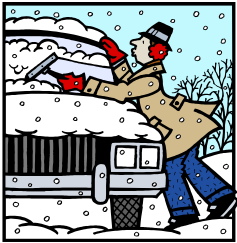Frigid temperatures not only slow us down, but can slow our van and accessible equipment. For example, if you use a hydraulic wheelchair lift, you may have noticed that the colder the weather, the slower the lift reacts. The cold thickens the fluid, making it move slower through hoses, valves and cylinders.
There’s not much you can do about that, but preparing other equipment for cold weather is important to help avoid accidents and breakdowns.
If you live in northern climates, get an oil change, tune-up, and/or semi-annual lift service and have any other accessible equipment checked before the temperature dips. A professional should also check the battery, antifreeze level, heater, brakes, defroster and thermostat.
Do It Yourself:
- Purchase winter wiper blades that cut through snow and ice.
- Keep the gas tank at least half full. It reduces condensation and makes your vehicle easier to start on cold mornings.
- Buy tires that have MS, M+S, M/S or M&S on them, meaning they meet the Rubber Manufacturers Association guidelines and can bite through mud and snow.
- For better traction and control, rotate tires so the best ones are in the front.
- Get an electric engine block heater. It warms the engine so the motor can start. It connects to normal AC power overnight or before driving. In extremely cold climates, electrical outlets are sometimes found in public or private parking lots.
- Cold weather is tough on accessible van batteries. Buy one with greater starting power, higher cold cranking amps and reserve capacity for energy when the engine isn’t running.
- Use synthetic oil to make starting a cold engine easier.
Before you drive:
- Keep rock salt on hand to melt ice off walkways for a safer wheelchair ride.
- Clean the snow off the roof and hood so it doesn’t “avalanche” onto the windshield and block your vision.
- Clear the head and tail lights for best visibility.
- Scrape the ice off mirrors and windows.



